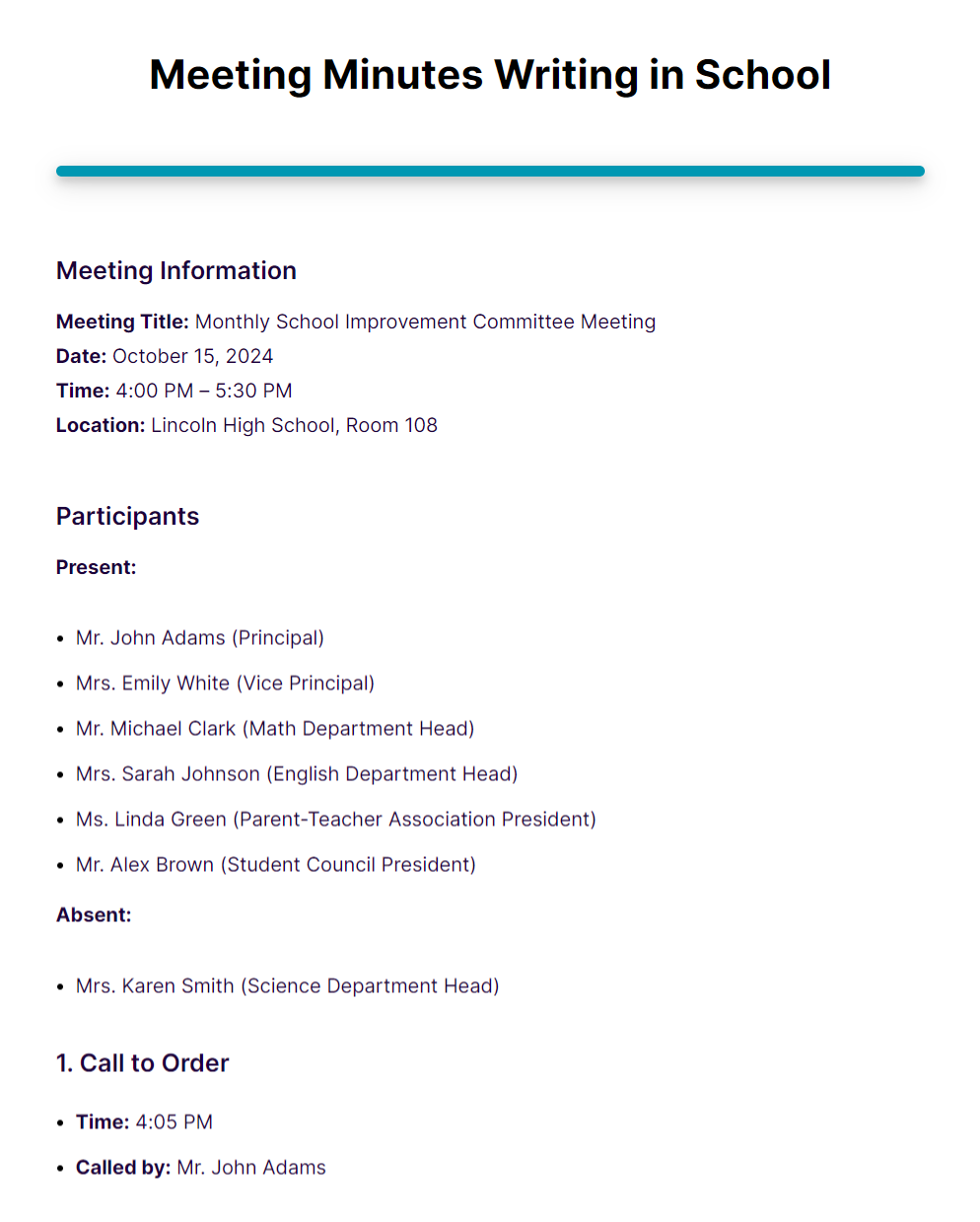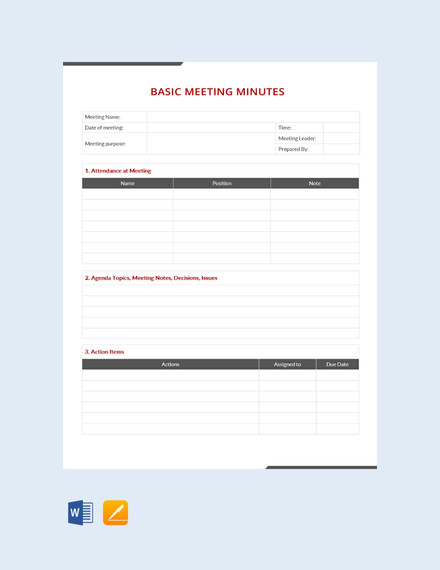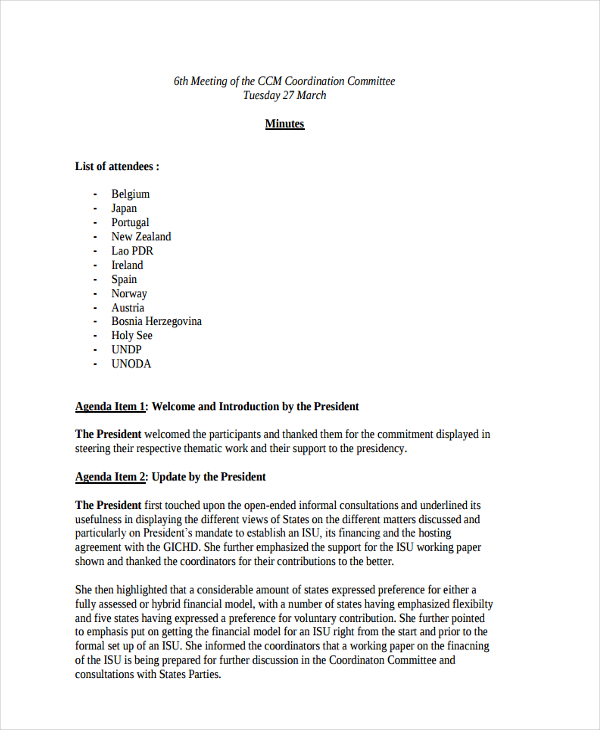13+ Minutes Meeting Writing Examples to Download
Conducting a plan for meeting in a company is quite essential and is one of the most crucial steps to be taken in every organization. The meeting allows an organization to properly tackle the important matter which affects the organization, both negatively and positively as well. They also help in solving issues of the organization and enable the company to function and conduct daily operations to the best of its abilities.
Details of such meetings always need to be recorded for future references. Such meetings often include important matters that are to be discussed during the meeting. You can also take a look at formal writing examples and samples for more. In this article, we will be discussing what a minute meeting is, how and why is it a vital process conducting a meeting and the likes.
What is Minutes Writing?
Minutes writing is the task of recording what happens during a meeting, including the discussions, decisions, and tasks that people agree to do. It’s like keeping a detailed note so that everyone knows what was decided and who is supposed to do what after the meeting. This way, there’s a clear record that can be looked back on for information or to check what was agreed upon.
In minutes writing, the writer firstly discusses the meeting in full details with the others, without missing any points, It records all the necessary data about the events of the meeting, which includes
- a list of all the people who are not present and also, who are attending the meeting,
- the matters considered by the meeting participants, and
- conclusions or decisions regarding such matters.
The minute of the meeting is mainly is typically written by the secretary of the organization. You can also take a look at the article writing examples and samples that are available online for more.

Download Sample Meeting Minutes Bundle
Minutes Writing Format
Introduction
- Minutes document the key points, discussions, and decisions of a meeting, serving as an official record. This guide outlines a clear and concise format for effective minutes writing.
Heading
- Meeting Title: Purpose of the meeting.
- Date and Time: When the meeting occurred.
- Location: Venue of the meeting.
- Attendees: List of participants and absentees.
Call to Order
- Opening: Chairperson opens the meeting, noting the time.
- Welcoming Remarks: Brief welcome to participants.
Approval of Agenda
- Agenda Review: Mention the agenda was reviewed.
- Modifications: Changes to the agenda.
- Approval: Method of agenda approval.
Approval of Previous Minutes
- Review: Previous minutes were reviewed.
- Corrections/Amendments: Any modifications to previous minutes.
- Approval: Approval status of the minutes.
Reports
- Committee/Member Reports: Summaries of key reports.
- Financial Report: Overview of financial status.
Old Business
- Follow-up: Updates on previous agenda items.
- Decisions Made: Decisions regarding old business.
New Business
- Presentation of New Items: New agenda items discussed.
- Discussions: Summary of discussions.
- Decisions and Actions: Decisions made and assigned actions.
Announcements
- Upcoming Events: Information on future events.
- Other Announcements: Additional significant announcements.
Adjournment
- Closing: Formal meeting closure by the chairperson.
- Next Meeting: Date and location of the next meeting.
Signature
- Preparer’s Name: Person who prepared the minutes.
- Date: Date the minutes were completed or approved.
Best Example of Minutes Writing
Download Free in Word Download Free in PDFMinutes of the Quarterly Marketing Strategy Meeting
- Meeting Title: Quarterly Marketing Strategy Meeting
- Date and Time: April 15, 2024, 10:00 AM – 12:00 PM
- Location: Conference Room B, Marketing Department, Main Office
- Attendees: John Doe (Chair), Jane Smith, Alex Johnson, Emily White, Michael Brown. Absent: Sarah Green.
Call to Order
- Opening: John Doe formally opened the meeting at 10:05 AM.
- Welcoming Remarks: John welcomed all participants and thanked them for their time.
Approval of Agenda
- Agenda Review: The agenda was presented and briefly reviewed.
- Modifications: Added “Social Media Campaign Review” under New Business.
- Approval: The agenda was approved unanimously.
Approval of Previous Minutes
- Review: The minutes from the January 2024 meeting were reviewed.
- Corrections/Amendments: No corrections or amendments were needed.
- Approval: The minutes were approved as presented.
Reports
- Marketing Analysis Report: Jane Smith summarized the Q1 marketing analysis, highlighting a 15% increase in engagement on our digital platforms.
- Financial Report: Michael Brown provided an overview of the marketing budget, noting that expenses were 5% under budget for Q1.
Old Business
- Website Redesign Update: Alex Johnson updated the team on the website redesign project, indicating it is on schedule for a June launch.
- Q1 Advertising Campaign Results: Emily White presented the results, showing a 20% increase in leads generated compared to Q4 of the previous year.
New Business
- Upcoming Product Launch: Discussion on marketing strategies for the new product launch in September. Agreed on an integrated approach utilizing social media, email marketing, and online ads.
- Social Media Campaign Review: Alex Johnson proposed a new social media campaign focused on user engagement. The team discussed various ideas and agreed to move forward with a pilot in Q2.
Announcements
- Marketing Conference: John Doe announced a marketing conference in July and encouraged team members to submit proposals for presentations.
- Team Building Activity: Scheduled for May 20th, details to be confirmed.
Adjournment
- Closing: John Doe closed the meeting at 12:00 PM, thanking everyone for their contributions.
- Next Meeting: Scheduled for July 10, 2024, at 10:00 AM in Conference Room B.
Signature
- Prepared by: Emily White
- Date: April 16, 2024
Minutes Meeting Writing Samples to Edit & Download
- Minutes Writing for First Meeting
- Minutes Writing for Self Help Group
- Minutes Writing for a Board Meeting
- Minutes writing for a Church Meeting
- Meeting Minutes for Bank Account
- Meeting minutes for Interview
- Meeting Minutes for LLC
- Meeting Minutes for Corporation
- Meeting Minutes for IEP
- Meeting Minutes for Project Management
- Meeting Minutes for Business
- Meeting Minutes for Nonprofit
- Meeting Minutes for Teams
Minutes Meeting Writing Examples & Templates
Meeting Minutes Writing

Meeting Minutes Writing in School

Free Writing Meeting Minutes Template
Here is a high-quality template your company or department can use to write a minute form for your meetings. It helps you make the most effective minutes of the meeting as and when needed. All you would have to do is download the template, edit and modify it with the details of your meeting and you are good to go. You can check easy writing samples and example templates that are available online for more. Download the template now and you can save yourself a lot of time and effort in making the meeting minutes format from scratch. Check it out now!
Meeting Minutes Format Template
Download this above-mentioned easy format template you can use to help you create your meeting minutes for your company or organization. Since it is available on many file formats, you have the choice to pick the one you like best and edit it from there. Take a look at writing templates and examples that are available online for more information on how to make the perfect minute meeting needed. You can do so in the comfort of your house. Just pick the template that suits you best, enter your details and you are good to go. Grab the template now!
Sample Meeting Minutes Template
The above-mentioned sample meeting minutes form can be downloaded to help you make one on your own. This template is free to download and easy to use. Another added advantage of using this template is that it is not just limited to the computer, but you can also download it with ease on any electronic device. Our expert designers have taken the effort to make it easier for you to add your meeting data and information without much hassle. Try this template out now and make the best minute meeting for your organization!
Simple Basic Meeting Minutes Template
Basic Meeting Minutes Template
Writing Meeting Minutes Template
Professional Minutes of Meeting Format
Meeting Minutes
Office Minutes of Meeting Sample
Formal Minutes Sample
Board Minutes Outline
Formal Minute Example
Purpose of Minutes Writing:
Minutes writing aims to record the entire meeting in the easiest way possible. Writing the minutes allows one to have a summary of the meeting, making it easier for others to understand. This meeting minutes can also be referred to in the future for more.
It also serves to inform the absentees of the agenda of the meeting, especially the most important ones. Writing the minutes allows the members of the organization to properly manage and record the exchange of inputs and information during the meeting. It is another form of effective communication that is internal and for the organization only. In writing the minutes one needs to pay attention to what the participants do and say, which means, the writer needs to pay attention to even the smallest detail during the meeting.
Minute Writing Format
Minutes of the Meeting Sample
Tips for Writing the Minutes
In minutes writing, one must make sure that every information that is included in it must be complete and accurate. Below are a few tips which might be useful for you in writing minutes of a meeting for your organization:
- Make the necessary preparations for the meeting – Read the minutes of the previous meeting, so that it gets easier for you to understand what you can do and also, read the proposed agenda of the board for the upcoming meeting.
- Only include things that matter – This is so you don’t find writing what everyone says the word for word.
- Learn to use keywords in place of certain phrases – Replace specific phrases with keywords. But you need to understand the keywords so you don’t get confused.
- Simplify descriptions – Directly describe what you observe in the meeting. Avoid adding adjectives or making notes about the emotions of participants. You may also see what do you mean by writing skills?
- If you’re confused, speak up – Politely ask for clarifications when getting confused in the middle of the meeting.
- Learn to distinguish important matters from chit chat – In meetings, people often go off-topic very suddenly, so you also need to pay attention to where the conversation is going.
- Consider using a recorder – If you’re worried that you cannot keep up with the discussion, try to record it instead. However, you need to inform the meeting participants that they are being recorded.
- Review the minutes – After the meeting, it is essential to review the details you’ve written in the minutes before creating the final copy. Essay writing examples and samples can be of great help to you. Check them out.
How to Write Minutes Meeting?
The best way to write meeting minutes effectively combines preparation, clarity, and organization. Here are key steps to achieve this:
1. Prepare Before the Meeting
- Familiarize yourself with the agenda, participants, and the goal of the meeting.
- Review previous minutes to understand pending actions or ongoing issues.
- Use a template that aligns with your organization’s format, including sections for attendees, agenda items, decisions, action items, and other relevant information.
2. Take Detailed Notes During the Meeting
- Record key points, decisions, and action items rather than transcribing everything said.
- Note the names of speakers for important points or decisions when necessary.
- Clearly mark action items, assigning each task with a responsible person and a deadline.
3. Write the Minutes Soon After the Meeting
- While the details are fresh in your mind, start drafting the minutes.
- Begin with basic information: the title of the meeting, date, time, location, list of attendees, absentees, and the main objective of the meeting.
- Organize the minutes according to the agenda, documenting discussions, decisions, and action items under each agenda topic.
4. Be Clear and Concise
- Use simple, straightforward language.
- Focus on outcomes and agreements rather than detailed discussions.
- Avoid personal commentary or judgment; keep the record neutral and objective.
5. Include All Essential Information
- Decisions made and any votes or consensus reached.
- Action items, with a clear description of the task, who is responsible, and the deadline.
- Important discussions and any items to be held over for the next meeting.
6. Review and Edit
- Check for clarity, grammar, and accuracy. Ensure that the minutes are understandable even to someone who did not attend the meeting.
- Align with any co-note-takers or the meeting leader to fill in gaps or clarify uncertainties.
7. Distribute and Seek Approval:
- Share the draft minutes with the meeting leader for preliminary approval.
- Once approved, distribute the minutes to all attendees and possibly other stakeholders who need to be informed.
- Store the minutes in an accessible location for future reference and record-keeping.
8. Follow-Up
- Monitor the progress of action items and prepare to report on them in the next meeting.
What is important in meeting minutes writing?
- Accuracy: Ensure that the minutes accurately reflect what was discussed and decided during the meeting.
- Clarity: Write in a clear and concise manner, using plain language. Avoid jargon or overly technical terms.
- Objectivity: Maintain a neutral tone and avoid expressing personal opinions or biases.
- Structure: Organize the minutes with a clear agenda, headings, and bullet points for easy navigation.
- Attendees: List all attendees, specifying who was present and who was absent.
- Action Items: Clearly record action items, specifying responsible individuals and deadlines.
- Decisions and Resolutions: Document any formal decisions or resolutions made during the meeting, including the names of those who proposed and seconded motions.
- Discussion Summaries: Summarize key points of discussions and any alternative viewpoints presented.
- Time Tracking: Note the time when each agenda item was discussed to help in tracking the meeting’s progression.
- Attachments: Mention if any documents or presentations were shared during the meeting, and provide links or references if applicable.
- Follow-up: Include any follow-up tasks or topics scheduled for future meetings.
- Signatures and Approval: Indicate who prepared the minutes and obtain approval from the meeting participants at the next meeting.
How do you write meeting minutes for beginners?
1. Preparation
- Obtain the meeting agenda and any relevant documents.
- Ensure you have a template or format to follow.
2. Record Basic Information
- Date, time, and location of the meeting.
- Names of attendees, specifying who is present and absent.
3. Create a Structure
Follow a simple structure with headings:
- Meeting Details
- Attendees
- Agenda Items
- Action Items
- Decisions
- Next Meeting
4. Agenda Items
- Summarize each agenda item, starting with the item number and title.
- Write concise notes about the discussion, highlighting key points and any disagreements.
5. Action Items
- List tasks assigned during the meeting.
- Include the responsible person, deadline, and any specifics.
6. Decisions
- Document formal decisions and resolutions.
- Include the names of those who proposed and seconded motions.
7. Next Meeting
Mention the date and time of the next meeting.
8. Keep it Simple
- Write in clear, plain language.
- Avoid jargon or technical terms.
9. Approval
Share the draft minutes with meeting participants for review and approval in the next meeting.
General FAQs
1. What is a Minutes of Meeting?
Minutes of the meeting are a written or documented record that is used to inform attendees and others about what has been discussed or what happened during a meeting. It records what actions that have been assigned to whom and what are the deadlines they need to finish the work by.
2. What is the Purpose of using Minutes of Meeting?
The purpose of using minutes of a meeting is to create an official record of all the actions that must be taken. It tells everyone about the action taken, especially for those who couldn’t attend it. It has the details of the roles and responsibilities, the achievements and the deadlines to be met.
3. What should Minutes of Meeting include?
Minutes of a meeting should include the meeting’s basic details, a list of attendees, agenda items with summaries, decisions and action items, and the date of the next meeting.
4. Who prepares Minutes of Meeting?
The minutes of a meeting can be prepared by a minute taker, who is the attendee at the meeting. His/her essential role is to record the events of a meeting. The language may be formal and professional, so it can be easily understood. They can also be an active participant in the meeting.
5. What is the Format of A Minutes of Meeting?
The minutes of the meeting begins with the name of the person/department who is holding the meeting. The primary function of it is to record all the decisions made, so all official decisions must be included without fail. By using this, those who have missed the meeting know what needs to be done.
6. Why are they called meeting minutes
Meeting minutes are called so because they are a “minute” (my-noot) or detailed record of what happens during a meeting, capturing the essential discussions, decisions, and actions in written form.
















